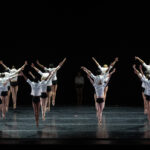In honor of Black History Month, we are highlighting women and men who have made and continue to make an incredible impact on the ballet world.

Virginia Johnson
Virginia Johnson began her ballet training at the age of three and went on to study at The Washington School of Ballet, where she was the only African-American student at the time. She went on to study at New York University as a dance major. While in New York, she met legendary dancer Arthur Mitchell, who invited her to start a ballet company. In 1969, Virginia left college and became one of the founding members of Dance Theatre of Harlem, the first-ever all-black ballet company. During her time there, she rose to the rank of principal and retired in 1997. She then went on to found Pointe Magazine after earning a communications degree from Fordham University, and served as editor-in-chief for 10 years. She returned to Dance Theatre of Harlem in 2009 to serve as their Artistic Director and remains in that position today. Over the course of her career, she has received such honors as Young Achiever Award from the National Council of Women, Outstanding Young Woman of America and the Dance Magazine Award, a Pen and Brush Achievement Award, the Washington Performing Arts Society’s 2008-2009 Pola Nirenska Lifetime Achievement Award, and the 2009 Martha Hill Fund Mid-Career Award.
Raven Wilkinson
Raven Wilkinson fell in love with ballet at the age of five after seeing the iconic company, Ballet Russe de Monte Carlo, perform. Her mother decided to enroll her in ballet classes where she displayed a natural talent. At the age of nine, she attended the Swoboda School, which later became the Ballet Russe School and gave her the opportunity to audition for the dance troupe. Despite her amazing talent, Wilkinson faced a number of barriers due to her race. It took Raven auditioning on three separate occasions before she was accepted on a six-week trial basis. She would go on to dance for the company for 6 seasons and was promoted to soloist. During her time with Ballet Russe, she faced a number of obstacles, especially when touring in the then segregated South. Exhausted from years of discrimination, where she was asked by producers to lie about her background, asked to wear white makeup, and even had individuals in the crowd shout racial slurs at her, she decided to leave the company in 1961. After taking a two-year break from dancing, she returned to the ballet world when Sylvester Campbell, a principal dancer with the Dutch National Ballet, suggested she audition for the company. She was invited to join them as a second soloist and performance with them for seven years. Homesick, she returned to the U.S. and was immediately asked to perform with the New York City Opera and performed with them until the company disbanded in 2011.
Arthur Mitchell
Credited as the first African-American dancer with the New York City Ballet (NYCB), Arthur Mitchell helped pave the way for black dancers in the ballet world. As a teenager, Mitchell was encouraged to apply to the High School of Performing Arts in New York City and upon his acceptance decided to train for a career in classical ballet. After graduating, he was awarded a scholarship to the School of American Ballet. In 1955, after a brief stint on Broadway, Mitchell made his debut with NYCB, performing in George Balanchine’s Western Symphony. He went on to become a principal dancer with the company a year later. During his time with NYCB, he performed in all major ballets. The pas de deux in Balanchine’s famous ballet Agon, was choreographed specifically for Mitchell. He left the company in 1966 to return to Broadway. He also helped found ballet companies in Washington, D.C., Italy, and Brazil. After the assassination of Dr. Martin Luther King, Jr., Mitchell returned to Harlem, determined to provide dance opportunities for children in the community. He went on to co-found Dance Theatre of Harlem, renowned for being the first Black classical ballet company, where he served as Artistic Director and choreographed a multitude of works.
Janet Collins
Unlike most ballerinas, Janet Collins made a name for herself by starring in lead roles on Broadway. She began training in ballet when she was young and in 1932, at the age of 16, auditioned for Ballet Russe de Monte Carlo. Similar to Raven Wilkinson’s experience, she would have been required to paint her face and skin white, so she decided not to join the company. Instead she joined the Dunham Company, founded and directed by Katherine Dunham, who is considered to be the “matriarch of black dance.” After some time with Dunham’s company, Collins moved to New York where she performed on Broadway, including one notable role in Cole Porter’s production of Out of This World, which earned her the Donaldson Award for best dancer on Broadway in 1951. She went on to be the first Black ballerina to perform at the Metropolitan Opera in Aida and Carmen. Later on in her life, she taught modern dance at the School of American Ballet and Marymount Manhattan College before retiring in 1974.
Desmond Richardson
Hailed by The New York Times as one of the greatest dancers of his time, Richardson’s talent was immediately recognized when he was a student at the High School for the Performing Arts. During that time, he was awarded a scholarship to attend the Alvin Ailey American Dance Center. In 1987, he joined Alvin Ailey’s company, where he was promoted to principal. After leaving the company, he traveled around the world and performed as a guest artist with renowned companies including Teatro alla Scala, San Francisco Ballet, Paris Opera Ballet and The Bolshoi Theatre. In 1996, he joined American Ballet Theatre and became the first African-American male dancer to promoted to principal dancer. In addition to his ballet career, Richardson also performed on Broadway, where he was nominated for a Tony Award for his role in the musical Fosse. He currently serves as one of the Artistic Directors of Complexions, a contemporary ballet company he co-founded with Dwight Rhoden.
Lauren Anderson
At the age of seven, Lauren Anderson began training at Houston Ballet’s Ben Stevenson Academy. She was inspired after seeing a performance by Dance Theatre of Harlem, where she saw ballerinas that looked just like her. At the age of 18, Anderson joined Houston Ballet’s Corps de Ballet. In 1990, she made history and became the first African American principal dancer at that company. Her titular role in Ben Stevenson’s ballet Cleopatra, gained her international recognition and the reputation of being a powerhouse on stage. In 1990, she received the Special Jury Award at the International Ballet Competition, as well as the International Critics Award. Anderson retired in 2006, but continued working for Houston Ballet doing education and community engagement programing. In 2016, the pointe shoes from her final performance were placed in the Smithsonian’s National Museum of African American History and Culture.
Katherine Dunham
Katherine Dunham is a legend in the dance world. Born in 1909, in Chicago, she had never thought about career in dance and had instead pursued teaching. She studied at the University of Chicago, where she was one of the first African American women to attend that school. She earned her bachelor, masters, and doctorate in anthropology. Through her studies, she traveled to the Caribbean and did field world in Jamaica and Haiti. Dunham’s career in dance began 1928, when she started ballet training with Ludmilla Speranzeva, a former Russian dancer. A few years later, at the age of 21, Dunham founded Ballets Nègres, one of the first black ballet companies in the United States. After some success, she turned her focus to modern dance and in 1933, opened her first school, called the Negro Dance Group, where she taught young black dancers about their African heritage. Dunham developed her own technique, a combination of modern dance with Afro-Carribbean and African-American influences. A year later, she was a guest artist with the Chicago Opera. In the 1940s, her dance company toured around the world. Her travels allowed her to author numerous articles, short stories, and books. In the 1965, Dunham accepted a position of Artist in Residence at Southern Illinois University. During her time there, she secured funding for the Performing Arts Training Center, with programming focused on the youth in the community. Later in her career she accepted a lot of choreographic commissions in the United States and Europe. She was an advocate for racial equality and used her performances to highlight the discrimination by boycotting segregated venues in the United States. Throughout her life, she received countless awards, including the Presidential Medal of Arts, NAACP Lifetime Achievement Award, Lincoln Academy Laureate, as well as an honorary doctorate from Harvard. In 2000, Dunham was named “America’s irreplaceable Dance Treasure” and was a true celebration of art and dance in the United States.
Carlos Acosta
Born is Havana, Cuba in 1973, Carlos Acosta was the youngest child in a family of 11. He began studying dance at the National Ballet School of Cuba at the recommendation of his father, who thought it would help his very energetic son. He was a naturally gifted student and in 1990, won the gold medal at the prestigious world ballet competition, Prix De Lausanne. Acosta was then invited to join the English National Ballet, where he became the company’s youngest ever principal dancer. After suffering an injury, that forced him to return to Cuba, he spent six months dancing with the National Ballet of Cuba under the direction of Alicia Alonso. During this time, he was offered a principal position at Houston Ballet, where the spent the next five years. Wanting to expand his repertoire, he returned to England in 1998 with the Royal Ballet, performing lead roles and touring the world. In 2003, his title changed once more to Principal Guest Artist, allowing his career to thrive as a guest artist with leading companies in the United States, Russia, Italy, France, Argentina, Japan, China, Germany, and Australia. He has won a slew of awards, including the title Commander of the Order of the British Empire (CBE). In 2015, he retired from the Royal Ballet stage, however, continues to dance and choreograph with his own company called, Acosta Danza, in Havana.
Debra Austin
Debra Austin made history in 1982 at Pennsylvania Ballet, when she became the first African American woman to be promoted to the rank of principal at a major American ballet company. She began dancing at the age of eight, and four years later, earned a full scholarship to School of American Ballet in New York City. Four years after that, she was handpicked by George Balanchine to join New York City Ballet. This was Austin’s first time making history as the African American woman to join the world-renowned company. As a dancer with NYCB, she danced many principal roles in both Balanchine and Jerome Robbins’ ballets, including one that was filmed for a PBS television special, Live From Lincoln Center. She then left New York City for Europe, where she danced with the Zurich Ballet and was promoted to the rank of soloist. In 1982, Austin returned to the United States and joined Pennsylvania Ballet. She retired in 1990 and now serves as Ballet Master of Carolina Ballet.
Alonzo King
A world-renowned contemporary ballet choreographer, Alonzo King, has put his stamp on the dance world through his creativity and company, Alonzo King LINES Ballet. Originally from Georgia, King grew up in Santa Barbara, California with civil rights activist parents, Slater King and Valencia King Nelson. It was there, King began his dance training. As he got older, he continued his training in New York City at the Alvin Ailey School, American Ballet Theatre School, and School of American Ballet. His early career included an apprenticeship with the Alvin Ailey Dance Theatre along with several performance opportunities with Dance Theatre of Harlem and various European companies. In 1982, King moved to San Francisco where he founded the Alonzo King LINES Ballet with a focus on creating works of his own. His style has been described as “the clean lines of classical ballet training infused with non-Western spirituality and movement traditions that place intention and quality of movement over customary ballet shapes and steps.” (Paula Peters, BlackPast) His works have been performed all over the world including the Royal Swedish Ballet, Les Ballets de Monte-Carlo, Joffrey Ballet, Alvin Ailey, Hong Kong Ballet, San Francisco Ballet, and Hubbard Street Dance Chicago. In 2019, he received an Honorary Doctorate from The Juilliard School in recognition of his significant contributions to the dance world.







